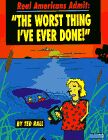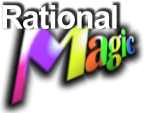|
GENRES:
Nonfiction
AUDIENCE:
Adults, teens; sex, language, drug use.
SYNOPSIS:
Ted Rall, winner of the Robert F. Kennedy Award for Outstanding
Cartoonist in 1995 and a finalist for the Pulitzer in 1996, spent
a while collecting stories about the worst things people did
in their lives--not the "dumb-worst" things like dropping
a hair dryer into the bathtub, but the "bad-worst"
things, like robbery, drug use, animal abuse, and even murder.
The stories range from a single page to ten pages in length.
Sample stories:
- "Felicide," in which a man tries to kill a cat
because it leaves dead animals on his car seat.
- "Mausoleum," where a group of boys stuff another
boy into a mausoleum drawer and leave him overnight.
- "Credit Card," about a college student who stole
money from his parents' credit card and vanished, leaving them
to unknowingly pay the rent on his now-abandoned apartment.
- "Leona's Silence," where Leona can't bring herself
to tell a woman that the man she's sleeping with has AIDS.
- "Buchenwald," a memory of a Japanese-American soldier
during World War II who helped liberate Buchenwald, but who could
not bring himself to shoot a former prisoner when she begged
him to.
- "Commission," where a woman has to have her mother
forcibly committed to a home.
The book includes a substantial introduction by Rall that
details why he chose to create this book and the effort he put
into finding stories for it. Basically, "What's the worst
thing you've ever done?" is his standard icebreaker question.
Also, the project was inspired by a book called Sabotage in
the American Workplace by Martin Sprouse (Pressure Drop/AK
Press, 1992), which contains anecdotes of workplace revenge.
Rall considers his book "a snapshot of contemporary American
morality."
EVALUATION:
By turns funny, unpleasant, and pathetic depending on your point
of view (the animal abuse ones really bothered me), these stories
are interesting in a voyeuristic way. The book is sort of like
Ripley's Believe It or Not merged with the Jerry Springer
show. As you might guess, this is the kind of material that reads
better in small doses than in one whole book; reading about so
much nastiness all at once is a little unsettling, and also,
the accounts get repetitious after a while.
Rall's illustrations are fairly low-key given the situations;
his odd-eyed, cartoony style takes the sting out of some of the
incidents. I love his lettering!
 |
|
A typical Rall panel: about
half text and half picture. |
|
Copyright 1996, Ted Rall |
This book would be of interest to people who are fascinated
by the bad behavior of ordinary people. |



